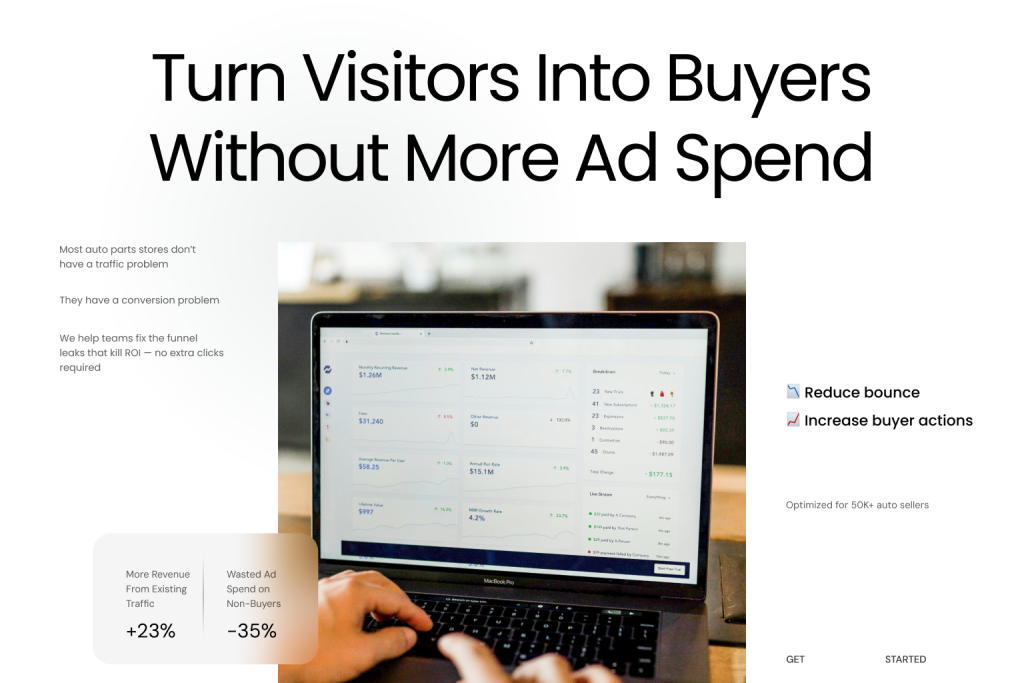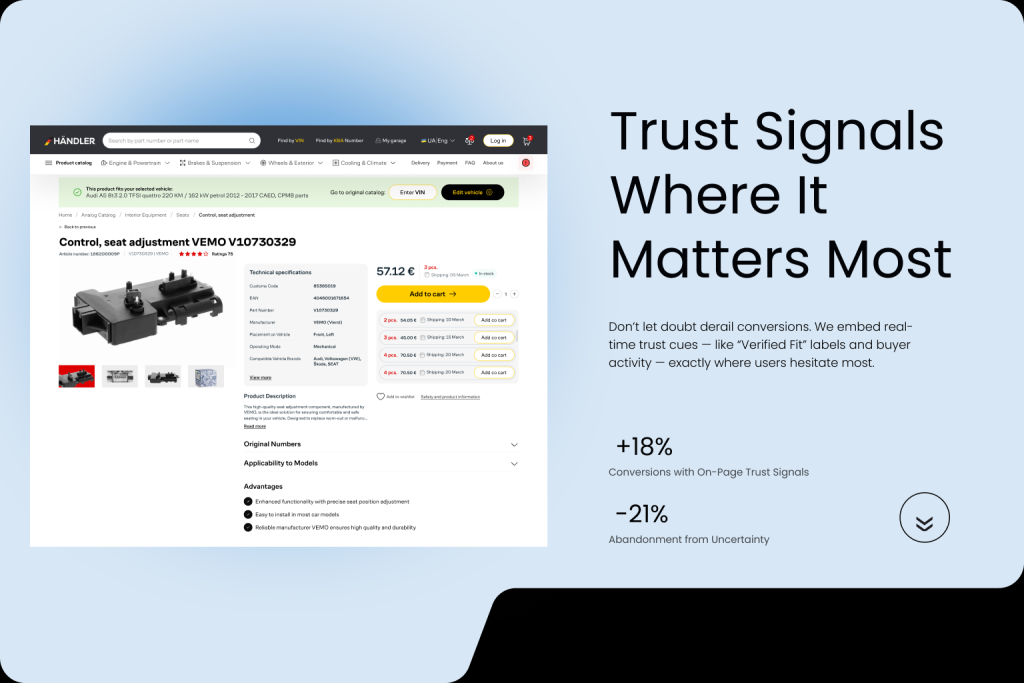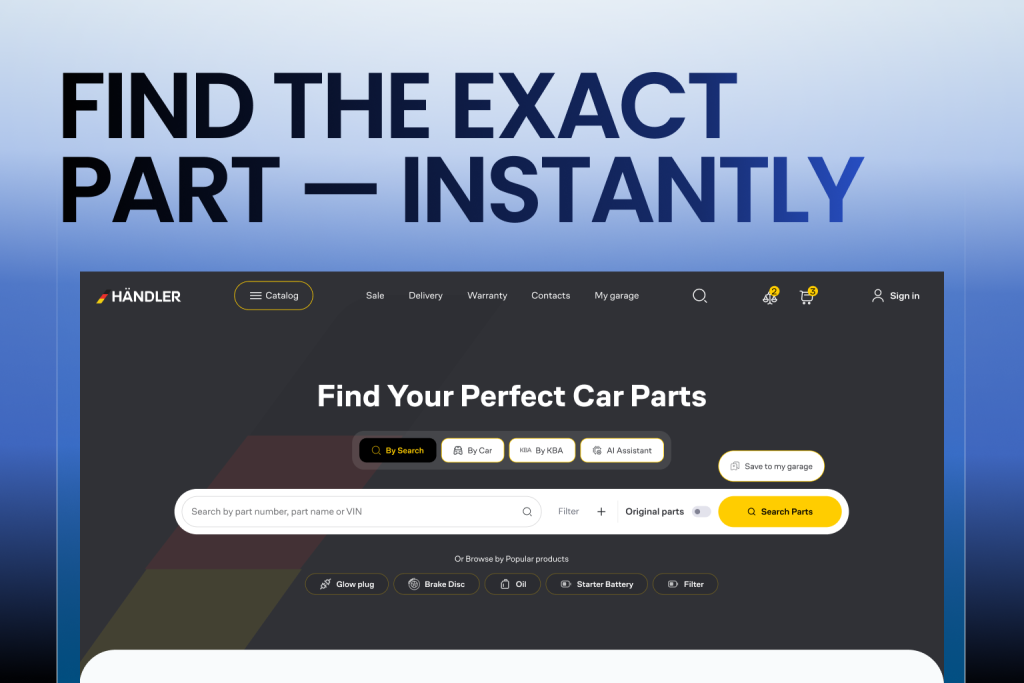Every auto parts eCommerce team loves a good traffic spike.
You’ve invested in Google Ads. You’re ranking on product keywords. Your social or email campaigns are driving visitors to your site.
But there’s a painful disconnect:
The traffic is up – and the revenue… isn’t.
If this sounds familiar, you’re not alone. One of the most common frustrations for growing auto parts stores is realizing that more visitors doesn’t automatically equal more sales. In fact, in many cases, increased traffic can make your inefficiencies more visible. You’re not scaling profit – you’re scaling waste.
So what’s going wrong?
It’s simple: your funnel is leaking.
And unless you fix the friction points between “visitor” and “buyer,” no amount of paid clicks or SEO traffic will deliver meaningful ROI.
Why This Problem Is Worse in Auto Parts eCom
Auto parts buyers are more cautious than typical eCommerce shoppers. They aren’t impulse-buying – they’re solving problems:
- “Will this fit my exact make and model?”
- “What if I buy the wrong part?”
- “Can I return it if it doesn’t work?”
- “Is this site legit?”
If your website doesn’t answer those questions at the right moments, users bounce. If your product pages don’t reassure, or your checkout adds friction, or you don’t recover lost carts – your traffic works against you.
The best auto parts teams know this. They don’t throw money at the top of the funnel – they fix the conversion flow. They optimize micro-UX, trust signals, fitment tools, checkout behavior, and remarketing – not by spending more, but by working smarter.
In this article, we’ll explore:
- The 5 hidden reasons your traffic isn’t converting
- What top-performing auto parts brands do differently
- How to increase ROI without increasing your budget
Reason #1: You’re Attracting the Wrong Visitors
It doesn’t matter how much traffic you’re getting – if it’s the wrong kind, it will never convert.
This is one of the most common (and costly) mistakes in auto parts eCommerce: investing heavily in ads, SEO, or social media content, only to attract users who were never going to buy in the first place.
Why does this happen?
Because the intent behind the click doesn’t match the content or offer on the page. You may be driving:
- DIYers looking for general advice, not ready to purchase
- Users searching for part specs or compatibility, not a transaction
- Price-sensitive shoppers comparing across 10 tabs
- People interested in content, not products
And if you’re running Google Ads or shopping campaigns without tightly controlling your keyword and audience targeting, you’re probably paying for non-buyers to visit your site.
Symptoms of Mismatched Traffic:
- High bounce rate (>60%) on key product or landing pages
- Short average time on site (<30 seconds)
- Low product page engagement (few clicks, no scroll depth)
- Very low “add to cart” or checkout initiation rates
- Huge difference between desktop and mobile behavior (e.g., mobile traffic doesn’t engage)
What Top Auto Parts Teams Do Differently:
Focus on Buyer Intent
They focus on long-tail, transactional keywords like:
- “buy serpentine belt Honda Accord 2015”
- “alternator for 2009 Dodge Ram online”
Not just “alternator function” or “what is a serpentine belt”.
Use Landing Pages That Match the Intent
They create segmented landing pages by:
- Vehicle (e.g., “Best parts for Toyota Tacoma 2018–2021”)
- Category (“Shop Brake Kits for SUVs”
- Use case (“Parts for winter driving”)
Segment Campaigns by Buyer Stage
They don’t show product ads to first-time info seekers. They retarget them later with trust-focused creative and offer pages when intent is higher.
Pre-Qualify the Click
High-performing teams use ad copy, meta descriptions, or CTAs that set the right expectations:
“Guaranteed fit. Free returns if it doesn’t work. 2-day shipping available.”
Result:
By tightening targeting and aligning landing pages with buyer-ready intent, teams see lower bounce rates, higher cart additions, and better ad ROAS – without increasing spend.
Reason #2: Your Product Pages Don’t Answer Buyer Doubts
In auto parts eCommerce, your product page is more than a place to show price and pictures – it’s a decision-making battlefield.
Visitors don’t just land on a page and click “Buy.” They’re scanning for confirmation – that the part fits, that the quality is good, that other people trust your brand, and that they won’t regret the purchase.
When your product pages don’t answer those doubts clearly and convincingly, the result is hesitation. And hesitation kills conversions.
This is especially true in auto parts, where buying the wrong item can cause frustration, delays, and extra costs. Unlike fashion or impulse shopping, customers here often need a little more proof – and a little less risk.
Yet, many stores fail at this stage. They rely on manufacturer descriptions, skip user reviews, and provide no fitment assurance, return clarity, or contextual reassurance.
The result? Users bounce, compare, or postpone.
Common mistakes include:
- No visible confirmation the part fits the user’s vehicle
- Generic product titles with no model/year info
- Sparse or copied descriptions with no added value
- No real user reviews or installation experiences
- Missing shipping details or vague return language
What top-performing auto parts teams do differently is simple but powerful: they treat every product page like a mini landing page, designed to build trust, reduce friction, and close the deal.
Here’s how:
- They show a clear “Yes, this fits your 2016 Ford Fusion” message once a user selects their vehicle or enters a VIN.
- They structure descriptions to highlight what matters: compatibility, specs, shipping time, and warranties.
- They feature authentic user reviews, often tagged with the reviewer’s vehicle model.
- They use trust badges, performance guarantees, and “frequently returned with” bundles to increase buyer confidence.
- They include small but effective microcopy like “Free return if it doesn’t fit – no questions asked.”
The result? Higher conversion rates, lower return rates, and longer session durations – without driving a single extra click. Because a great product page doesn’t just describe the part. It removes the fear.
Reason #3: Your Checkout Experience Is a Conversion Graveyard
You’ve done the hard work. The user searched, clicked, explored your site, and added the part to their cart. Now comes the final step: the checkout. But this is where many stores lose the sale.
The truth is, your checkout flow is one of the highest-friction stages in the customer journey – especially on mobile. And if it’s not fast, clear, and frictionless, it becomes a graveyard for intent.
Why Checkout Drop-Offs Happen
Auto parts buyers are often under time pressure. They might be standing in a garage, working on a car, or shopping between tasks. Any delays or frustration in the checkout process will cause them to back out and try a competitor.
Here’s what typically goes wrong:
- Too many steps or pages
- No guest checkout option
- Confusing form fields or layout on mobile
- No reassurance during checkout (e.g., shipping info, return guarantee)
- Poor error handling (no feedback when form data is invalid)
- Unexpected costs like shipping or taxes shown only at the last step
In short: the more the user has to think, the more likely they are to leave.
Read more in our previous article:
Why Trust Is the Real Conversion Engine in Auto Parts eCommerce
What Top Auto Parts Teams Do Differently
High-performing stores optimize their checkout with the same intensity as their ad campaigns. Here’s what sets them apart:
They simplify the process
- Fewer fields. Fewer steps. Often a single page or two-screen flow.
- Autofill and auto-detect features for address and email inputs.
They offer guest checkout
- No forced account creation. Just a quick email and payment.
They remove uncertainty
- Clear display of delivery times, shipping cost, and return options right next to the “Place Order” button.
They add payment flexibility
- Integrations with Apple Pay, Google Pay, PayPal, Klarna, and others.
They add mobile-friendly design
- Large buttons, sticky CTAs, thumb-friendly forms, and smooth transitions.
The Bottom Line
Checkout isn’t a form. It’s a final trust test.
Fixing it won’t just reduce cart abandonment – it will instantly increase your ROI from every visitor who gets that far. And the best part? It requires no new traffic, no new campaigns – just a better experience.
Reason #4: You’re Not Recovering Abandonment
No matter how optimized your site is, not every visitor will buy on their first visit. But that doesn’t mean the sale is lost. It just means you need a recovery plan.
Unfortunately, many auto parts eCommerce stores treat abandonment – whether it’s from the cart, product page, or mid-checkout – as a dead end. No follow-up, no reminder, no second chance.
That’s not just a missed opportunity. It’s a leak in your revenue funnel.
Why Users Abandon (and Why It’s Not Always Final)
Auto parts buyers abandon carts for dozens of reasons:
- They get distracted or interrupted mid-checkout.
- They want to compare prices or check with their mechanic.
- They’re unsure if the part will fit or if they can return it.
- Shipping time isn’t clear or guaranteed.
- The final price feels too high after taxes and fees are revealed.
What’s important to understand: many of these buyers are still interested – just not ready at that exact moment.
Without recovery systems in place, you lose them. But with a well-structured flow, you can win them back.
What Top Teams Do Differently
They trigger smart abandoned cart emails
Not generic reminders – but personalized messages that:
- Mention the exact item and vehicle
- Include reassurance copy like “Guaranteed to fit your 2017 Ford F-150”
- Remind the user of benefits: free returns, fast shipping, fitment guarantee
- Offer time-limited incentives (“Complete your order in 24 hours and get 5% off”)
They use retargeting ads strategically
Top teams show dynamic ads featuring:
- The exact item the user viewed or abandoned
- Trust-building messages (“100,000+ parts delivered. Rated 4.9 by verified buyers.”)
- Urgency triggers (“Only 3 left in stock for your vehicle”)
They deploy exit-intent or “Save Cart” features
- When users go to leave, they’re offered to email their cart to themselves
- Or shown a reminder about returns, support, or price-match guarantees
The ROI of Recovery
Recovery flows don’t just add incremental sales – they multiply the value of your existing traffic. Even a basic 3-email sequence can recover 10–20% of abandoned carts. For every 100 missed conversions, that’s 10–20 saved – without spending another dollar on ads.
Reason #5: You’re Not Tracking Micro-Conversions
If you’re only measuring completed purchases, you’re missing most of the story.
In auto parts eCommerce, users often go through multiple steps before converting – and each of those steps holds critical insight. These are called micro-conversions, and they’re the signals that reveal what’s working (and what’s not) across your site.
Ignoring them means flying blind. You’ll see traffic, and you’ll see sales – but you won’t understand why people drop off, where they hesitate, or what’s breaking their journey.
What Are Micro-Conversions?
Micro-conversions are meaningful user actions that indicate interest or intent, such as:
- Viewing a product page
- Selecting a vehicle in the fitment tool
- Clicking “Add to Cart”
- Starting checkout
- Expanding shipping or return details
- Using filters or search
- Watching a video or scrolling past 75% of the page
Every one of these is a mini trust milestone. When users stop short of the next step, it’s a signal that something needs fixing.
Why Not Tracking Them Hurts ROI
Let’s say 1,000 people view a brake pad page, but only 50 add to cart. Without tracking scroll depth or interaction, you won’t know:
- Did they scroll past the fitment badge?
- Did they open the return policy?
- Did they try to use the “Fits My Vehicle” tool – and bounce when it didn’t work?
Without answers, you’re optimizing in the dark. You may tweak headlines or run A/B tests without touching the real points of friction.
What Top Auto Parts Teams Do Differently
They track micro-events religiously, using tools like:
- Google Analytics 4 (GA4) with custom events
- Hotjar or Microsoft Clarity for heatmaps and session recordings
- Enhanced eCommerce tracking in Shopify or Magento
And more importantly – they act on the insights. For example:
- If most users drop off before clicking “Add to Cart,” they rework the product description and fitment reassurance.
- If users expand the shipping section but then leave, they simplify or clarify delivery expectations.
- If mobile users abandon halfway through checkout, they test button placement, form design, and autofill support.
Small Wins, Big Returns
By improving micro-conversion performance at each stage, they multiply the ROI of their traffic – not by spending more, but by converting more of what they already have.
Read in our previous article:
5 UX Mistakes That Kill Mobile Sales in Auto Parts eCommerce (and How to Fix Them)
You Don’t Need More Traffic – You Need More Momentum
If you’re pouring money into ads, SEO, or campaigns – but conversions aren’t following – the problem isn’t how many people visit your store. The problem is what happens after they arrive.
In auto parts eCommerce, visitors don’t convert by default. They convert when your website removes doubt, builds trust, and makes the buying process effortless – especially on mobile, where the majority of browsing now happens.
Let’s recap what top-performing eCom teams do differently:
- They attract qualified traffic, not just any traffic – by targeting buyer-ready search intent and matching it with intent-specific landing pages.
- They build product pages that convert, with fitment confidence, social proof, and copy that anticipates and answers buyer concerns.
- They streamline checkout, cutting down friction, offering guest options, and clearly showing delivery and return policies.
- They recover abandoned opportunities, with email flows, dynamic retargeting, and timely reassurance before the buyer forgets.
- They track micro-conversions, identifying and fixing leaks before they turn into lost sales – optimizing the entire experience, step by step.
And here’s the most important part: none of these tactics require a bigger ad budget.
They require better alignment, better messaging, better UX thinking, and above all – better use of the traffic you already have.
Because ROI isn’t just about getting more visitors. It’s about earning more value from the visitors you already paid for.
If you’re serious about growing your auto parts store without blowing your budget, it’s time to stop thinking like a traffic buyer – and start thinking like a conversion strategist.








